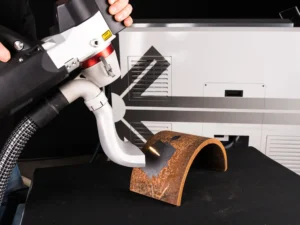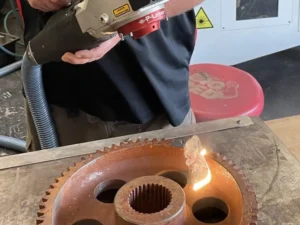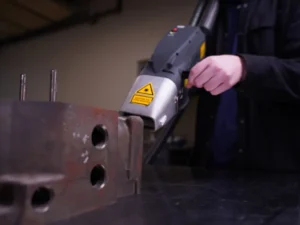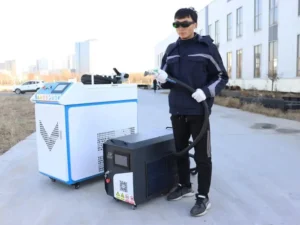Introduction:
Laser cleaning is a cutting-edge technology that has revolutionized the way we remove contaminants from various surfaces. Whether it’s removing rust from metal, paint from walls, or grime from delicate artifacts, laser cleaning offers a precise and efficient solution. How does laser cleaning work? In this article, we will explore the fascinating process of laser cleaning and understand how it works.
Understanding Laser Cleaning

The Basics of Laser Technology
Laser stands for Light Amplification by Stimulated Emission of Radiation. It is a device that emits a coherent and focused beam of light. The laser beam consists of photons, particles of light that carry energy. Laser technology has found numerous applications across industries, including medicine, manufacturing, and cleaning.
The Principles of Laser Cleaning
How does a laser cleaner work? Now let’s take a look at the principles of laser cleaning. The Principles of Laser CleaningLaser cleaning works on the principle of selective photothermal interaction. When the laser beam interacts with a surface, it absorbs energy from the photons, leading to heat generation. The absorbed energy causes the contaminants on the surface to vaporize or break down without damaging the underlying material.
How Does Laser Cleaning Work- The Process of Laser Cleaning

-
Preparing for Laser Cleaning
Before the laser cleaning process begins, it is crucial to prepare the surface appropriately. The surface is examined to determine the type of contaminants present and their adhesion strength. Factors such as the material type, surface condition, and laser parameters are considered to optimize the cleaning process.
-
Laser Parameters and Adjustments
Different materials and contaminants require specific laser parameters for effective cleaning. These parameters include laser power, wavelength, pulse duration, and repetition rate. Adjusting these parameters ensures that the laser energy is delivered optimally to the surface, maximizing the cleaning efficiency and minimizing potential damage.
-
Laser Cleaning Procedure
The laser cleaning process can begin once the surface is prepared, and the laser parameters are set. The laser beam is directed towards the surface, and as the laser energy interacts with the contaminants, several processes occur simultaneously.
-
Absorption
The contaminants on the surface absorb the laser energy due to their different optical properties compared to the underlying material. This absorption initiates the cleaning process by raising the temperature of the contaminants.
-
Vaporization
As the temperature of the contaminants increases, they reach their vaporization point. The absorbed energy is transferred to the contaminants, causing them to evaporate or sublime. The vaporized contaminants are expelled from the surface as a result.
-
Shock Wave Generation
During laser cleaning, the rapid expansion of the vaporized contaminants creates a shock wave. This shock wave exerts pressure on the remaining contaminants, loosening their adhesion to the surface.
-
Material Selectivity
One of the key advantages of laser cleaning is its material selectivity. Different materials have different absorption properties for various laser wavelengths. By selecting an appropriate laser wavelength, the energy is primarily absorbed by the contaminants, leaving the underlying material unaffected.
-
Laser Scanning
To ensure uniform cleaning, the laser beam is often scanned across the surface. This scanning process allows for comprehensive coverage and precise removal of contaminants. The scanning speed and pattern can be adjusted based on the requirements of the cleaning task.
Advantages and Applications of Laser Cleaning

Advantages of Laser Cleaning
Laser cleaning offers several advantages over traditional cleaning methods:
Non-contact:
Laser cleaning is a non-contact process, reducing the risk of surface damage.
Environmentally friendly:
It is a chemical-free and residue-free cleaning method, making it environmentally friendly.
Precise and selective:
Laser cleaning allows for the precise removal of contaminants without affecting the underlying material.
Efficiency:
It is a fast and efficient cleaning process, reducing labor and downtime.
Versatility:
Laser cleaning can be applied to a wide range of materials, including metals, stone, wood, and more.
Applications of Laser Cleaning
The applications of laser cleaning are diverse and expanding rapidly:
Historical artifact restoration:
Laser cleaning is used to delicately remove dirt and grime from valuable artifacts without causing damage.
Industrial cleaning:
It is employed to remove rust, paint, and coatings from various surfaces in manufacturing and maintenance processes.
Electronics industry:
Laser cleaning is used to clean delicate electronic components, removing contaminants that could affect their performance.
Automotive industry:
It helps in the removal of rust, coatings, and adhesives from car bodies and engine parts.
Aerospace industry:
Laser cleaning is utilized to clean and maintain aircraft parts, such as turbine blades and engine components.
Features to Look Out for While Opting for a Laser Machine

Laser machines have become indispensable across various industries, from manufacturing and engraving to healthcare and research. These machines offer precise cutting, engraving, and marking capabilities, making them highly sought after. However, with a wide range of available laser machines, it is essential to understand the key features to look out for when opting for a laser machine. This article will explore some crucial features that should be considered during the selection process.
1. Laser Type and Power
The first and foremost feature to consider is the type of laser and its power. There are different types of lasers, such as CO2 lasers, fiber lasers, and diode lasers, each with strengths and applications. The power of the laser determines its cutting and engraving capabilities. Higher laser power allows for faster and deeper cuts or engravings. It is important to choose a laser machine with the appropriate type and power based on the intended applications.
2. Work Area Size
The work area size of a laser machine refers to the available space for cutting or engraving. The size of the work area directly affects the maximum dimensions of the materials that can be processed. Considering the desired material sizes is crucial, and choosing a laser machine with a work area that accommodates those dimensions. Additionally, it is worth considering whether the machine allows for easy customization or future expansion of the work area.
3. Precision and Accuracy
Precision and accuracy are vital, especially when dealing with intricate designs or fine details. Laser machines with high precision and accuracy ensure that cuts, engravings, and markings are executed as intended. This feature is influenced by various factors, including the quality of the laser beam, the machine’s mechanics’ stability, and the control software’s precision. It is advisable to look for a laser machine with a reputation for delivering exceptional precision and accuracy.
4. Software and User Interface
A laser machine’s software and user interface significantly affect its usability and functionality. A user-friendly software interface makes creating, editing, and executing designs easier. Advanced software may offer features like vectorization, image tracing, and parametric design capabilities. Additionally, the software should control various settings, such as laser power, speed, and focal depth. Compatibility with popular design file formats, such as SVG or DXF, is also worth considering.
5. Cooling System and Ventilation
Laser machines generate heat during operation, and a reliable cooling system is necessary to maintain optimal performance and prevent overheating. Look for a laser machine with an efficient cooling system that can handle the heat generated by the laser source. Adequate ventilation is also important to remove smoke, fumes, and particles produced during the laser process. A well-designed exhaust system ensures a clean and safe working environment.
6. Safety Features
Safety should be a top priority when working with laser machines. Look for machines that incorporate essential safety features, such as emergency stop buttons, door interlocks, and laser beam safety enclosures. These features help prevent accidents and protect operators from exposure to laser radiation. Additionally, some laser machines may have features like automatic focus adjustment or protective shields to enhance safety during operation.
7. Maintenance and Support
Consider the maintenance requirements and available support for the laser machine. Regular maintenance is essential to ensure the longevity and performance of the machine. Look for machines that are easy to maintain and come with clear instructions and documentation. Additionally, consider the availability of technical support, software updates, and spare parts. Reliable customer support ensures timely assistance in case of any issues or questions that may arise.
8. Price and Return on Investment
Finally, consider the laser machine’s price and evaluate its return on investment. While it is essential to consider the budget, it is equally crucial to assess the capabilities and features of the machine about its price. A machine that meets your requirements and provides a good return on investment in productivity, quality, and durability is often a wise choice.
Conclusion:
How does laser cleaning work? By the end of the read, I’m sure you have a general idea. Laser cleaning is an advanced and versatile technology that provides an efficient and precise method for removing contaminants from various surfaces. By harnessing the power of laser beams, this process offers advantages such as non-contact cleaning, material selectivity, and environmental friendliness. With its expanding applications, laser cleaning plays a significant role in industries ranging from manufacturing to restoration, contributing to enhanced efficiency.
